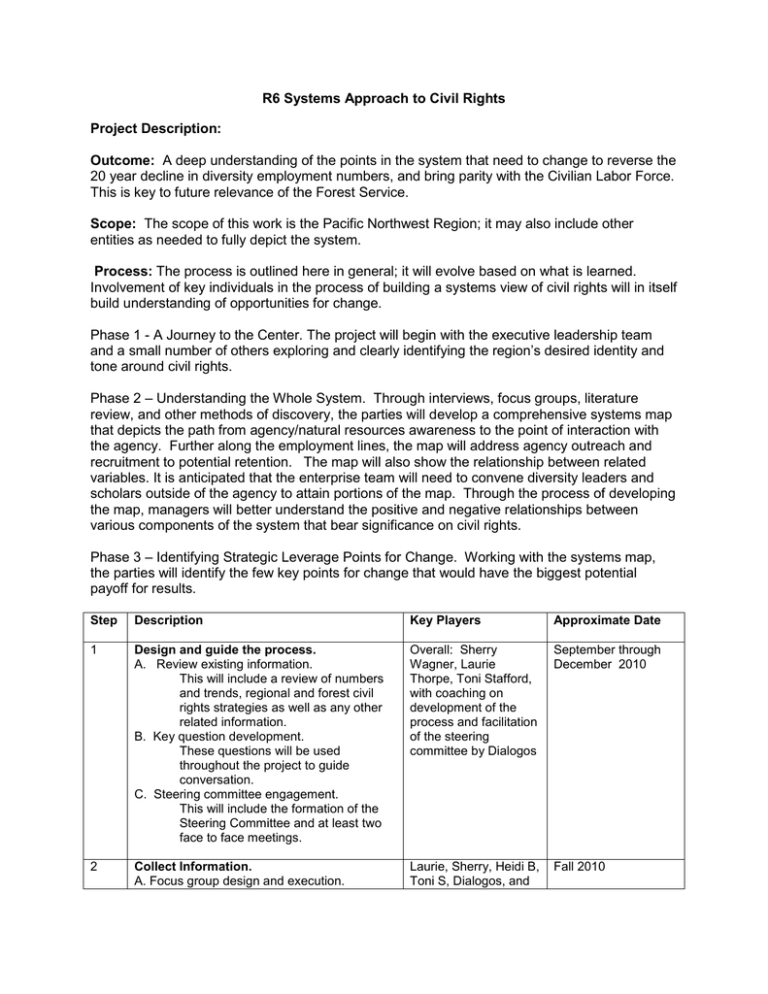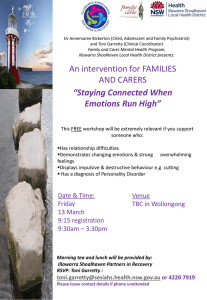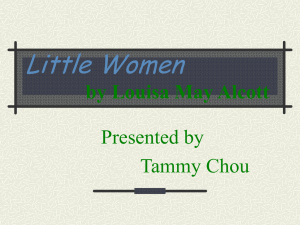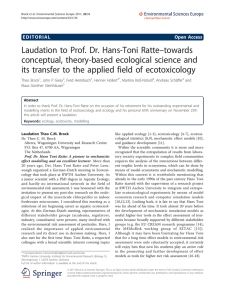R6 Systems Approach to Civil Rights Project Description: Outcome:
advertisement

R6 Systems Approach to Civil Rights Project Description: Outcome: A deep understanding of the points in the system that need to change to reverse the 20 year decline in diversity employment numbers, and bring parity with the Civilian Labor Force. This is key to future relevance of the Forest Service. Scope: The scope of this work is the Pacific Northwest Region; it may also include other entities as needed to fully depict the system. Process: The process is outlined here in general; it will evolve based on what is learned. Involvement of key individuals in the process of building a systems view of civil rights will in itself build understanding of opportunities for change. Phase 1 - A Journey to the Center. The project will begin with the executive leadership team and a small number of others exploring and clearly identifying the region’s desired identity and tone around civil rights. Phase 2 – Understanding the Whole System. Through interviews, focus groups, literature review, and other methods of discovery, the parties will develop a comprehensive systems map that depicts the path from agency/natural resources awareness to the point of interaction with the agency. Further along the employment lines, the map will address agency outreach and recruitment to potential retention. The map will also show the relationship between related variables. It is anticipated that the enterprise team will need to convene diversity leaders and scholars outside of the agency to attain portions of the map. Through the process of developing the map, managers will better understand the positive and negative relationships between various components of the system that bear significance on civil rights. Phase 3 – Identifying Strategic Leverage Points for Change. Working with the systems map, the parties will identify the few key points for change that would have the biggest potential payoff for results. Step Description Key Players Approximate Date 1 Design and guide the process. A. Review existing information. This will include a review of numbers and trends, regional and forest civil rights strategies as well as any other related information. B. Key question development. These questions will be used throughout the project to guide conversation. C. Steering committee engagement. This will include the formation of the Steering Committee and at least two face to face meetings. Overall: Sherry Wagner, Laurie Thorpe, Toni Stafford, with coaching on development of the process and facilitation of the steering committee by Dialogos September through December 2010 2 Collect Information. A. Focus group design and execution. Laurie, Sherry, Heidi B, Toni S, Dialogos, and Fall 2010 The use of focus groups or small group dialogue will be a key piece of gathering input to understand the system. B. Interviews. C. Develop the draft map. members of the RO CR team. 3 Identify key leverage points. Session with RLT where we use much of what we’ve learned to get their perspective and final input for the map, as well as gain understanding of the system and key leverage points Laurie, Sherry, Toni maybe Audrey P March 2011 4 Deliver Final Products. The final system map, report and Power Point. Laurie, Toni Summer, 2011 Deliverables: 1. A Causal Loop Systems Map. 2. A written Report of the process and key leverage points, which can lead to actions and change strategies. 3. A Power Point slide show summarizing the findings.



